Chris & Allyson vs. Italy & Croatia (June-July 2019)
Italy Day Two: Forum and Palatine, Circus Maximus, Jewish Ghetto, Great Synagogue, Pantheon, Piazza Navona, On the Tiber
You shouldn't live in the past, but it's nice to visit. On our second day in Rome, we were ready to absorb 14 or 15 centuries worth of knowledge. If you hydrate it's not that hard. The big plan was to see the Roman Forum and the Palatine Hill -- the pilot house for Western Civilization for at a few hundred years. What they lack in quality -- some of the ruins are kind of extra ruined -- they make up tenfold in quantity. Nobody does broken columns and suggestive foundations better than the Roman Empire. NOBODY.
Of course, these are some of the most popular tourist attractions in the world. And they were the only big Roman attractions where we didn't book in advance. Back in the day, you might have walked right into the Forum, the Palatine or the Colosseum on a lark. Today, during the busy season, they're pandemonium. If you don't have something pre-arranged, you're going to stand in a ticket line for a very long time ... just to buy a timed ticket for LATER that day. And people do this. We saw literally thousands of people from around the world, opting to waste the better part of a day standing in line, smelling terrible in the blazing summer heat. Rome wasn't seen in a day, but dear lord, why? (Or lords. When in Rome ...)
Savvy travelers like me, however, use an insider travel information service known as "Google." The interwebs informed me that the shortest line to enter the Forum and Palatine is the "back door" to the Palatine. The main Forum entrances are near the Colosseum, and once people get to that big central plaza they just see the lines and hunker down like idiots.
I'd like to tell you I wasn't such an idiot, but why lie? After a delightful breakfast on the roof deck of the Otivm, we strolled down the Via del Fori Imperiali, trusting in my Internet research and my ability to read street maps. (Very early in our marriage, Allyson ceded all map responsibilities to me, partly because I'm good at that stuff, but mostly because she loathes maps.) I got us to the Colosseum plaza. I spotted a sign that said "Palatine." I panicked, and immediately hunkered down in that line.
But the gig economy came to the rescue. Roman tourism supports a complex ecosystem of parasites. If there's a line outside an attraction, then there are almost certainly shifty looking men canvassing said line, promising you that you can skip it. It's not clear to me how or why this works, and it always makes you feel like you're being ripped off, but it's the system the Italians are going with. They once ruled most of the known world so I guess you gotta cut them some slack.
Long story longer: A gentleman who was too brown to be Italian made a couple of strafing runs on our line, barking about "skip the line" Palatine tickets with a guided tour. It seemed extremely sketchy. But it was also extremely hot, and Allyson and I were extremely open to the idea. We had rolled the dice on a "barker" in Budapest a few years earlier, with excellent results. So why not give it a try? I paid the guy 20 euros cash for each of us, and he handed us non-descript stickers that said "11:00" in hand-written scrawl. We were then told to go wait in the very limited shade cast by the Colosseum, on the pedestal where the Colossus of Nero once stood. We did this ... and the guy melted back into the crowd. The only consolation was other potential morons nearby, also sporting "11:00" stickers.
Just when it was getting close to the time for panic, another gentleman in an authoritative day-glo vest showed up. He led our group away from the center of the plaza, lined us up against a wall with no shade. He told us to wait for "Scott" ... and then melted back into the crowd. At this point, you are no doubt wondering if we have all of our kidneys by the end of this story. And we do. Against all odds, a Scott materialized within in a few minutes. He was a middle aged white guy in a floppy brimmed hat. Scott was originally from Scranton. He had dual citizenship, and he implied that he fled the United States after Trump's election.
And he was ready to give our group a tour, in English, of the Forum and Palatine.
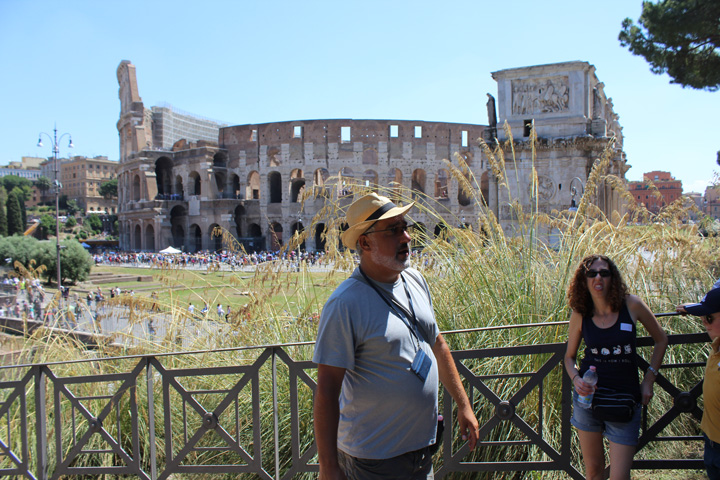
Super guide Scott gives us the lowdown on the Palatine Hill and the Forum.
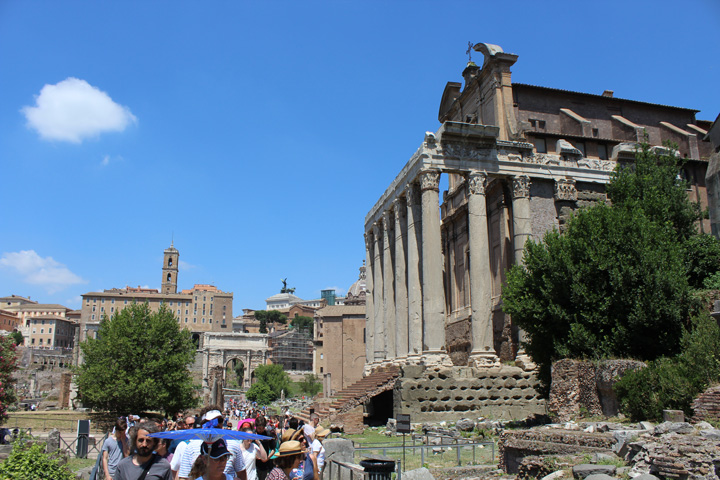
Nothing particularly funny happened on the way to the Forum. This time, at least.
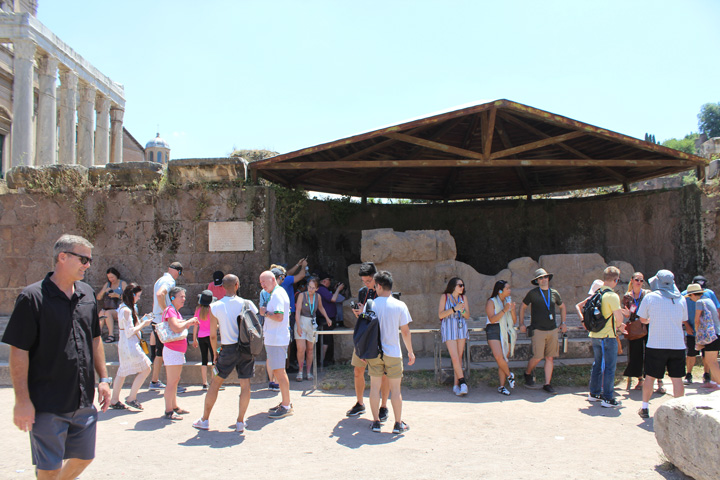
The spot where Julius Caesar's body was ... uh, rendered.
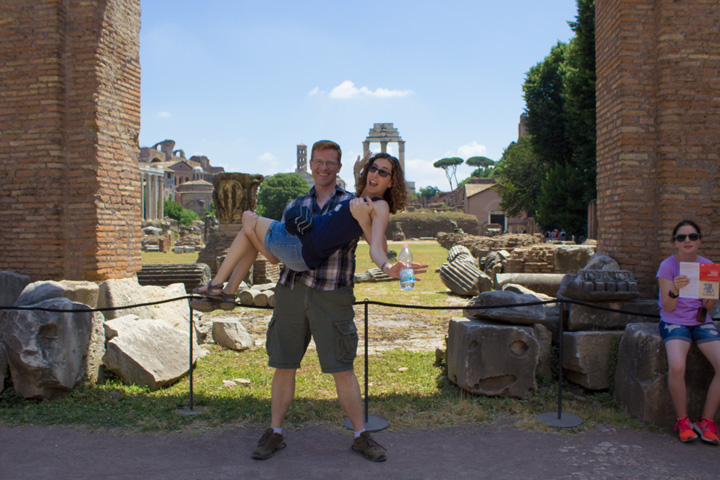
Picking up chicks in true Italian fashion, at the Forum.
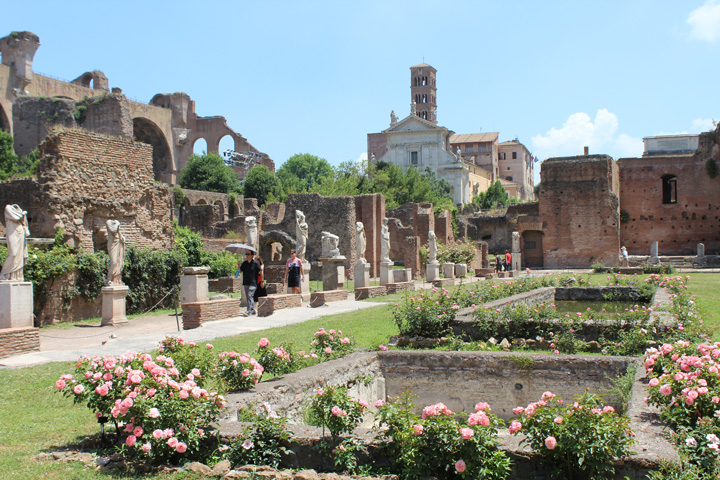
What's left of the house of the Vestal Virgins.
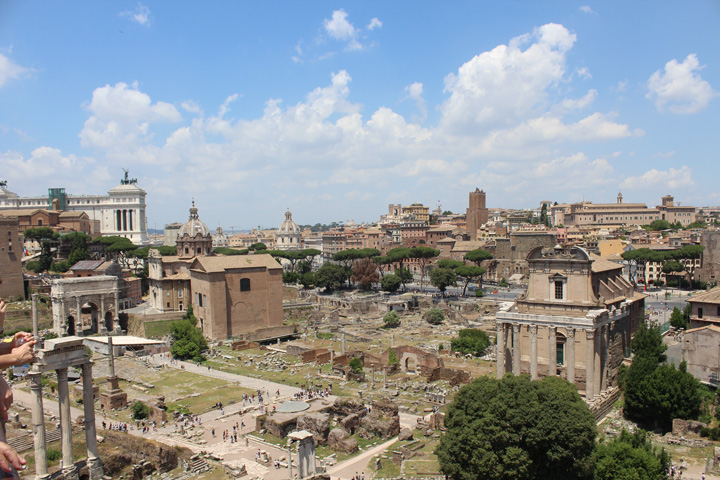
From the edge of the Farnese Gardens, an awsome panorama of history.
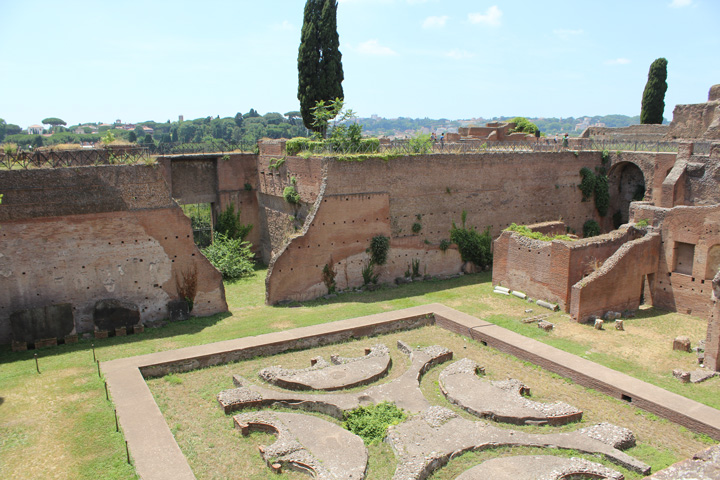
The remains of a huge fountain in the emperor's palace. Palatine Hill.
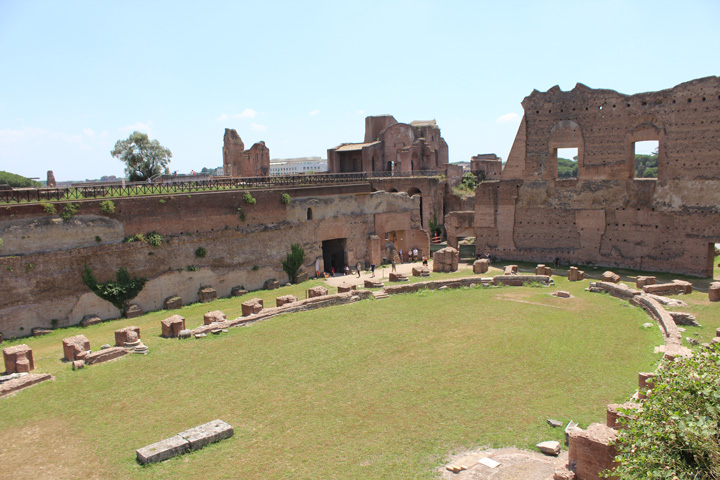
Why have a home gym when you could have a home stadium? Palatine Hill.
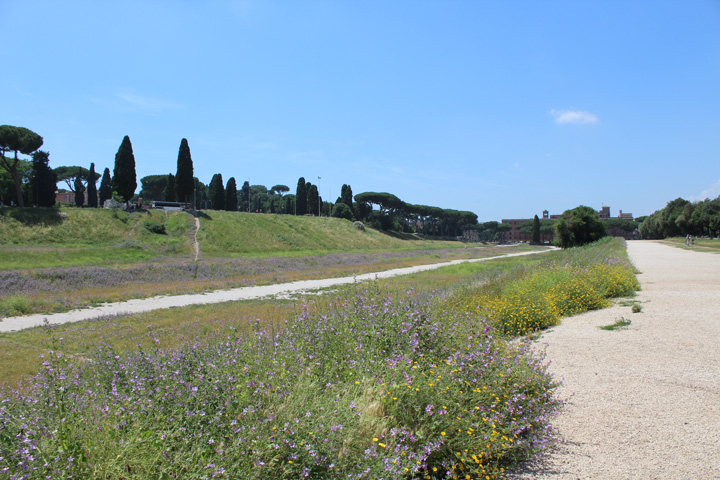
The less-impressive remains of Circus Maximus. Sort of minimus these days.
Best of all, it seemed to be a thoroughly respectable tour. It's daunting to sort out the details of one of humanity's greatest historic sites: Conceptually, the two sites are a junkyard of the ages. Most of the buildings have been reduced to fragments -- some are little more than a few columns -- and others were repurposed a dozen times before their collapse, with temples turning into offices turning into churches. Rome had its share of creative destruction.
But Scott hammered on recurring themes to help make sense of it all. After taking us through the Palatine entrance I had read about (where lines were, in fact, shorter) he explained that the Palatine Hill was the original center of Rome. There had been a walled enclosure on its top, where supposedly Romulus slopped together mud huts and got the party started. The city expanded far beyond the Palatine, but it kept its stature when Augustus developed it into the campus for his astonishing palace. Scott emphasized the miracle of Roman plumbing -- a necessity, once they realized that the green waters of the Tiber weren't exactly packed with electrolytes. To make sense of the palaces and temples around us, Scott discussed the dynamics of slavery in the Roman era, where the wealthy had almost unlimited leisure time and chose to fill it with social and political intrigue.
With the fundamentals in mind, we toured the highlights. We spied the three big barrel vaults of the Basilica of Constantine, supposedly the oldest surviving Basilica and an inspiration for the design of St. Peter's and other Catholic houses of worship. (Today, they show movies and hold concerts in the ruin in the summer.) We passed within feet of the Arch of Titus, a remarkably well-preserved monument carved with scenes from the Roman conquest of Jerusalem in 66 A.D. (Scott believed the Romans were the true raiders of the lost ark.) We walked down the original, time-polished stones of the Via Sacra. As the parade route for "triumphs" -- grand celebrations awarded to Rome's conquering heroes -- it was the same path where Caesar partied on his way to the top.
In the Forum proper, the ruins are a bit more ruined, but some things stood out. The house of the Vestal Virgins is now roofless, and they don't keep the fire burning, but it's still impressive. The curious Temple of Antonius and Faustina features a Baroque church glommed on to a Roman temple. You can spot marks on the columns where the invading Goths tried to pull the building down but failed -- Rome might have fallen, but its engineering didn't. That temple was also an excellent reminder that we were standing in a huge excavated pit, as you can see where the street-level entrance of the church had been, more than a story above our heads. The tour wrapped up near a "rostra" in the Forum, around the corner from the preserved spot where Julius Caesar was cremated. Always finish strong.
Expert tourists know that guides are part of the tour, so here's what we got in our brown-nosing chat with Scott after the tour ended: He had worked for Time Warner and was personally producing some documentary about the 2016 election. He claimed to have footage of the Russian spy lady at CPAC, and he said that he had been harassed by some mainstream journalists who didn't want the real story coming out. Scott was either a visionary or a leftist lunatic, but he gave a very engaging tour, and we can all look forward to the real story any day now.
There was more to see, and if it took the Romans a few centuries to make the Forum, we could at least budget four hours to see it. Armed with our guidebook, we poked around a few ruins at the bottom of the forum, then made our way back up the Palatine Hill via the Farnese Gardens. Dating to 1550, they were built as a pleasure garden on the ruins of an old palace. Cardinal Farnese was the grandson of Pope Paul III; he was appointed as a cardinal at age 14, and mostly collected art. The Catholic Church used to be more fun.
At the top of the hill we took a lazy stroll around the grounds of the Domus Flavia and Domus Augustana, what was left of the imperial palace and Augustus' original home. It was ungodly hot, but here's a fun fact about Rome: The fountains are all spitting out potable water, and they WANT you to drink it. You can refill your water bottle all over the place. Great hydration was clearly a big part of Rome's dominance.
Unfortunately, there are no glorious public artworks shooting out free sandwiches, so we split from the Palatine Hill when it was time for lunch. And there was a plan! We were giving part of our afternoon to Jewish history. Rome, like many European cities, has carved out cultural space to commemorate some its worst behaviors, including the treatment of its Jewish population. It's part of Allyson's heritage, and part of history writ large, so we have made a point of exploring these things when we can.
We strolled along the empty remains of the Circus Maximus (maybe the most underwhelming ruin in Rome) until we reached the Tiber. We followed that green-slime trail to the remains of the Jewish ghetto. And the plan was to find a highly recommended restaurant in our guidebook named "Piperno." In truth, we had no idea if the food was good. But the restaurant did come close to sharing a name with one of Allyson's favorite stuffed animals, Piper the koala. Amd we must honor Allyson's present as well as her past.
Maybe the guidebook was out of date, or maybe I can't read Roman maps -- let's go with the first one -- but Piperno was nowhere to be found. We settled instead on a light lunch at a small kosher place, in the heart of the ghetto, where the narrow winding streets are jammed with Jewish eateries. It was very good, and it gave us all the energy we needed to tackle the Great Synagogue and the Museo Ebraico.
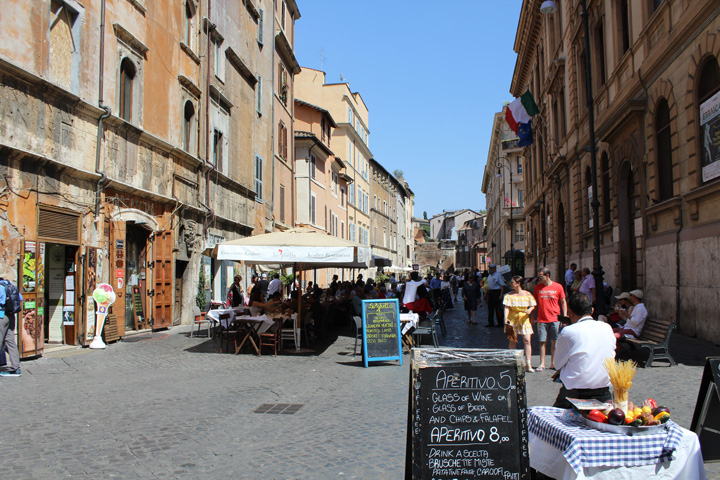
In the ghetto! Specfically, what was once the Jewish Ghetto of Rome.
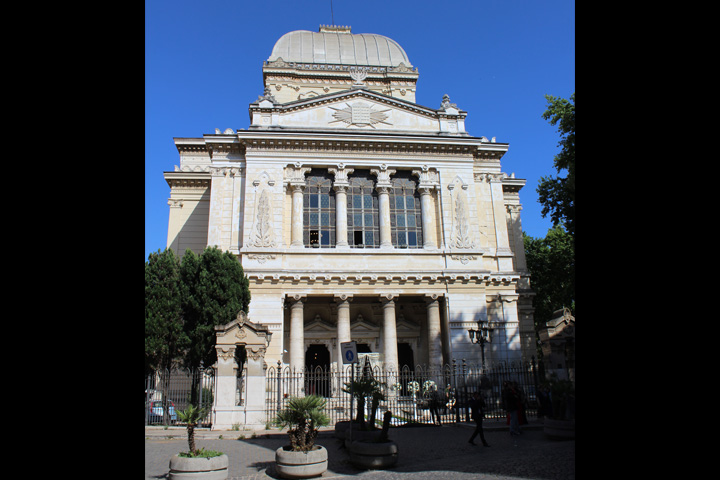
The astonishing Great Synagogue of Rome. Definitely visit if you're in town.
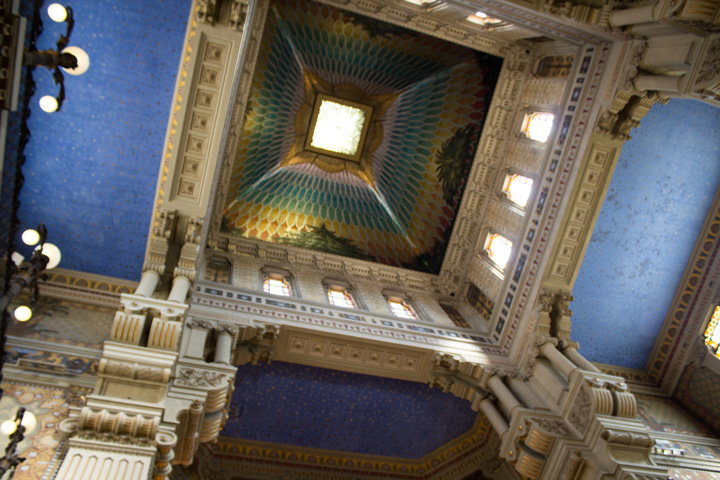
The Noah-inspired rainbow interior of the Great Synagogue's cool dome.
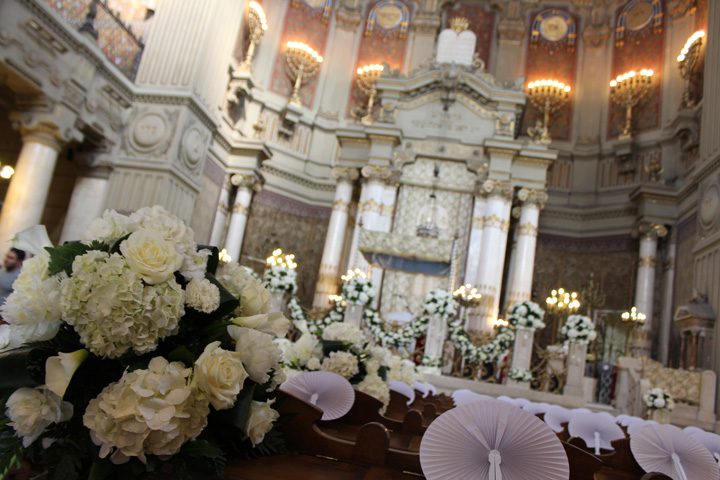
On our visit, the synagogue was decorated beautifully for an impending wedding.
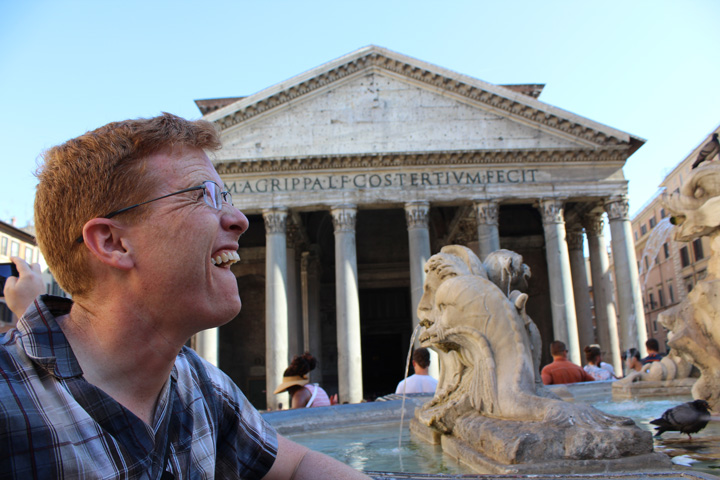
Well golllllleeeee! It's the Pantheon!
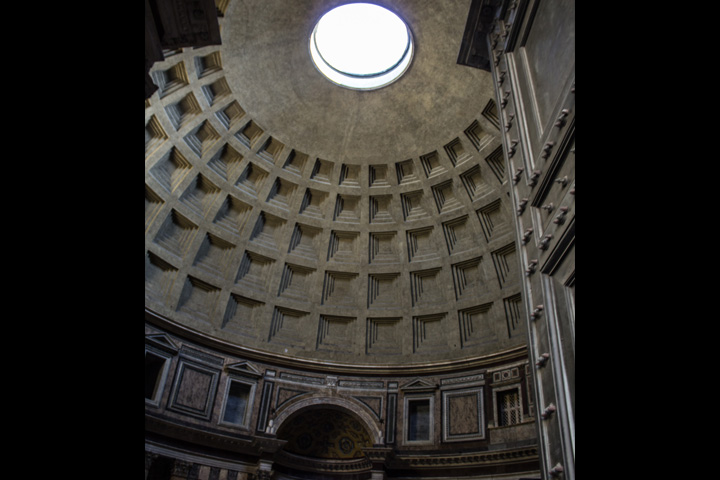
They forgot to finish the Pantheon roof and spun it off as a feature. Smart.
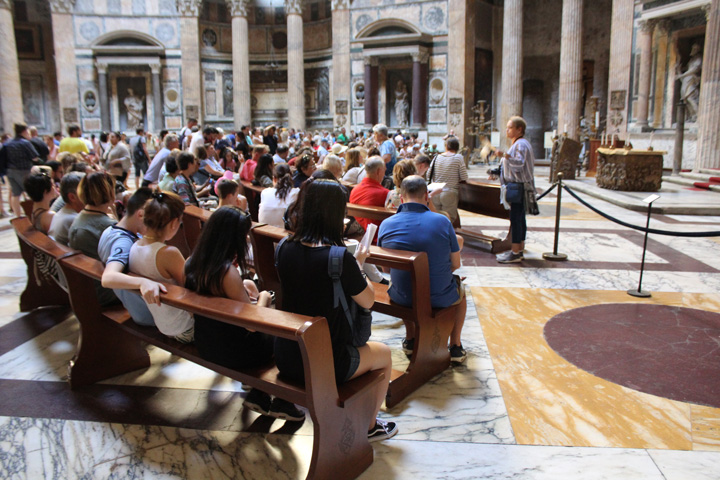
A reminder that the Pantheon is, to this day, one of the oldest functioning Catholic churches.
It was awesome. The current Great Synagogue was built in 1903 to replace a "multiplex" synagogue that no longer exists -- because the history of Jews in Rome isn't exactly pretty. Many Jews from the Iberian peninsula fled to Rome seeking shelter from the Inquisition. That ended up being a lateral move. During the "counter reformation," Pope Paul III got nasty and started aggressive attempts at converting the Jews to Catholicism. In 1555, Paul IV established a ghetto: a walled neighborhood where Jews were locked inside and forbidden to leave at night. There was compulsory church services for non-believers, and the church put restrictions on all Jewish economic activity, both in terms of what jobs they could do and who they could do business with. Some decades were better than others, but these conditions persisted through the 1870s. The Jews were allowed only one Synagogue, so the solution for the many different sects crammed into the ghetto was to make that synagogue a single building that housed five distinct areas for worship. It was a multiplex.
Oppression of the Jews began to wane in the late 19th century, and the Great Synagogue was built as a celebration of the newfound freedom. The Jews suffered a horrific reversal of fortune under Mussolini, who sold them out during WWII and shipped many of them to camps. But the building, miraculously, survived. After we read about the story of the Roman Jewish community in the excellent museum underneath the synagogue, they took us upstairs to check it out. It's stunning. It has a beautiful mash-up of influences, including Assyrian columns and a Roman Catholic basilica feel, but with the only squared-off dome in Rome. The interior of the dome is a rainbow symbolizing god's signal to Noah. It's a building where they colored to the edges of the page, with bright and intricate ornamentation in every direction. On our visit the synagogue was decorated for an impending wedding. The flowers made it even more beautiful, but honestly it doesn't need the help.
We're a sporting couple, though, so we decided to give the Catholics a chance to top it. Rome has a very walkable historic core, and even with my recent map fail I was confident that I could get us to the Pantheon. It's not hard to find; you just look for everyone with a camera and follow them. The "temple of all the gods" was planned in the first century and completed in the second; and despite numerous collapses of the Italian political order and several world wars it's still looking pretty good. This is thanks in part to a solid design by the emperor Hadrian -- who probably had some other guy design it, then took the credit and murdered that other guy to keep him quiet -- and because it was converted to a Catholic church in the 7th century.
It is still theoretically a functioning church, but it doesn't feel that sacred. Maybe it's more solemn on some days, but as we waited in the entrance line, the guys in front of us had to chug their beers before crossing the threshold. The crowds inside pay no attention to the polite requests for silence, and lots of tourists just sit on the floor when they're bored.
It's still something to see, though! The dome (and its very famous oculus) seems too astonishing to be so old. And the walls are adorned with the mildly fancy tombs of the artist Raphael, and the first two Italian kings. The kings are from the 19th century, and placing them in the Pantheon was clearly a naked attempt to co-opt the gravitas of Roman history. Still, if you have to be dead, you might as well do it in style.
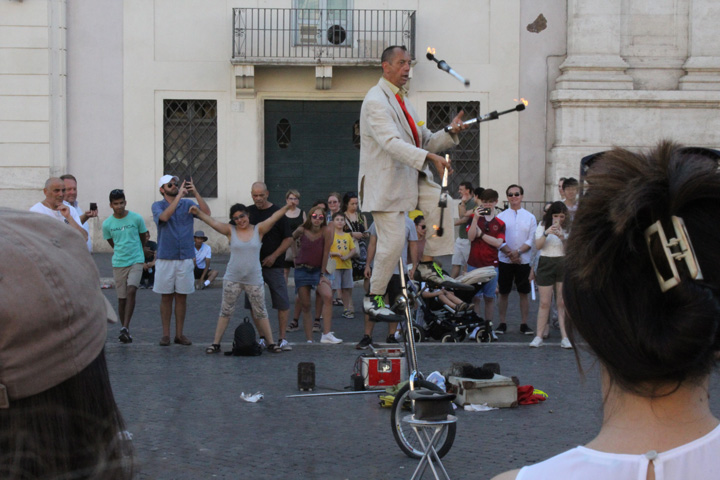
Street performers can be found in lots of the piazzas. They're not all this cool, though.
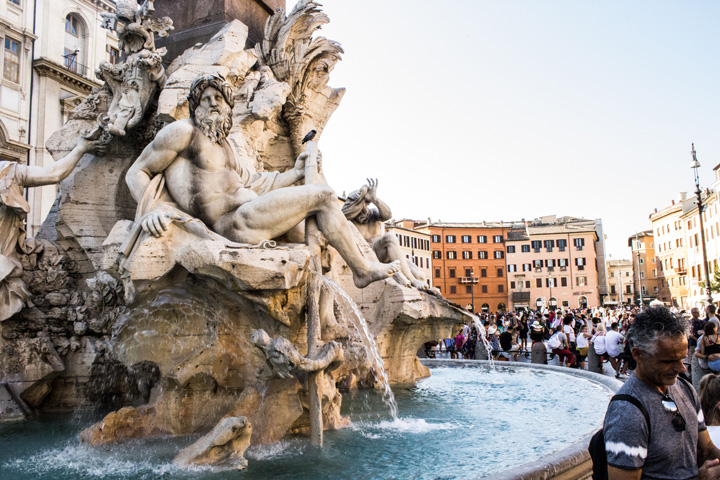
The fountain of the Quattro Fiumi, which sounds like an Olive Garden menu item but isn't.
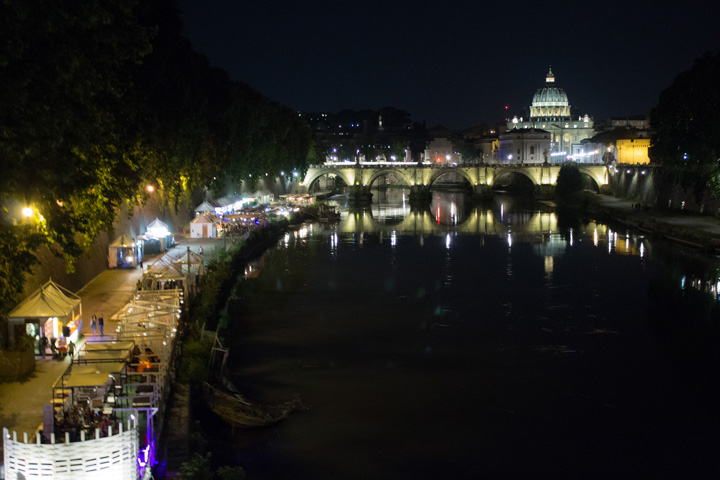
Crossing the Tiber at night, a look down toward Vatican City. You can see the vendor stalls on the banks.
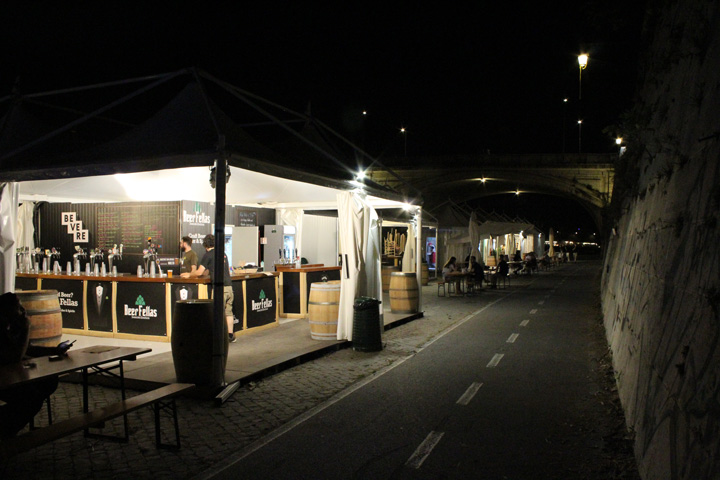
Stopping for a late-Sunday night beer at the annual Tiber festival.
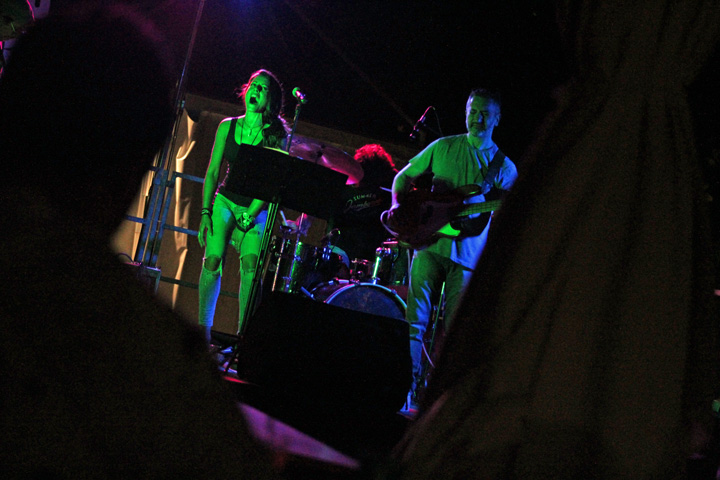
An outdoor Italian blues band at 10 p.m. on Sunday? YEAH!
The rest of the day was a slow glide to the finish. We took a short stroll to Piazza Navona to see the fountains there: the fountain of the Quattro Fiumi, the moor wrestling the Dolphin, and one of Neptune. There are several piazzas and fountains that the guidebooks say you MUST see, and looking back, they're mostly a blur. The fountains are pretty, and they all have great stories of papal patrons and genius artists and bizarre local traditions. The piazzas all have charming restaurants and great people-watching and bizarre street performances. We saw a guy juggling flaming things while riding an elevated unicycle, just like in ancient Roman times. You see these things, you take a picture, you check the box, then you forget the details when it's time to write about them a few months later. The info's in the guidebook if you need it.
We returned to the hotel for a drink on the rooftop -- if you got it, flaunt it -- then went to a restaurant recommended by a friend from DC. Maccheroni (not far from the Pantheon) was nothing fancy, but we enjoyed good conversation and excellent pasta, surrounded by a mix of locals and tourists. I had the arrabiata, in case you were wondering.
After dinner we strolled down to the Tiber and over one of the bridges near the Castel Sant-Angelo. It was late, and we were tired, but the sound of live music convinced us to descend to the level of the river. In summer, the Tiber is transformed by the "Lungo Il Tevere," a summerlong setup of pop-up restaurants, merchants and performance spaces all along the banks. We heard live blues and funk from an Italian trio, singing almost entirely in English. You haven't heard "Superstition" until you've heard it from a middle-aged Italian lady at 10 p.m. on a Sunday. Trust me.
